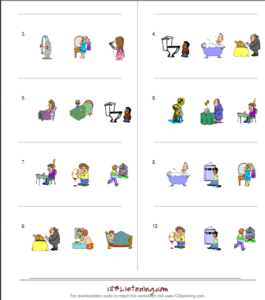In my grade 4/5 classroom, I have noticed that students often do not listen carefully to instructions. I have searched for listening tasks that students can complete independently. In this task, students will be given a multiple choice answer sheet that consists of pictures. They will play the audio clip, and then select the best picture to match each question.
Learning Outcome:
Students will listen to a sentence, form a mental image, and then match their mental image to a choice of images.
Carter (2012) differentiates between listening and hearing, in that, “hearing is a physical process that involves autonomic responses, whereas listening is a psychological process through which the listener processes
what he or she hears in order to make meaning of what is being said.” Originally I wanted to try finding a short audiobook that students could image from, but I was looking for a short example that could be used as an introduction to the process of listening carefully and thinking about what was said.
I did find many YouTube videos which would have been usable as I could cut the audio from them; however, I had little success finding one that was labeled open source. In searching the web, I came across a site that is designed mainly for ESL learners. The materials on this site are free for teachers to download and use, and the website appears to be funded through advertising. Although these materials are not exactly what I was looking for (too easy), they will still work as an introductory exercise for the class. The audio can be used as is, without further editing.
Listening worksheet:

Audio Clip:
References and Sources:
Ready to print listening tests. (n.d.). Retrieved March 10, 2022, from https://123listening.com/files/print-worksheets.php?file=dailyroutines1_ccp3
Carter, C. W. (2012, October 26). Instructional audio guidelines: Four design principles to consider for every instructional audio design effort. Techtrends: Linking Research & Practice to Improve Learning, 56(6), 54–58.

Tiernan McIntyre
March 13, 2022 — 12:16 am
Hi Geoff,
This seems like a fun activity. The audio clip is clear and well timed; giving students enough time to process the words spoken and find the most appropriate image. My daughters and I really enjoyed doing the test although number five, wakeup, caused a small fight. One child selected the person sleeping and the other, a person making/getting into bed. I guess this just reinforces the importance of choosing images carefully.
Alana posted a collection of audiobooks you might find interesting from LibriVox.
Tiernan